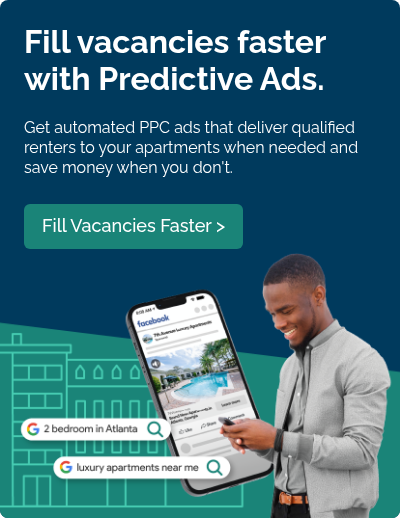Are you seeking to fill your vacant units faster? And how are you addressing this in your apartment's marketing strategy?
Hoping to achieve a faster leasing velocity with marketing that never changes doesn't work.
It needs to be:
- Immediate
- Proactive
- Relevant
- Efficient
All four become possible with pay-per-click digital advertising. You control the visibility, budget, messaging, placement, and timing of what prospective residents see online.
That dynamic control puts you in a better position to avoid losing $100,000+ in lost rent revenue due to slow leasing velocity.
In this blog:
- Why apartment marketers should pay attention to and actively improve leasing velocity.
- How dynamic apartment ads are designed to fill vacancies faster.
Why should apartment marketers care about improving leasing velocity?
Never doing anything to change your leasing velocity comes with a price.
Say your studio floorplan has six vacant units. Leasing one of those units takes about 30 days. The average rent price is $1,435/month.
If that leasing velocity never changes, you're losing:
- $287/day
- $2,009/week
- $8,610/month
That's just one floorplan. Imagine how those numbers compound when you're always dealing with stacks of vacancies like this in other floorplans every month. That's $104,755/year in vacancy loss! (Not to mention the losses from discounting rents to move units faster.)
But, apartment marketers, you can prevent this.
You can actively adjust your marketing and generate more qualified leads faster, boosting leasing velocity and reducing your total number of vacant days.
And that's possible with dynamic apartment ads.
Dynamic apartment ads are designed to fill vacancies faster.
The unfortunate truth is that you can only rent one unit of a floorplan at a time.
So, when you have six available studio units and it takes around 30 days to lease one, you could accrue up to 180 days of vacancy.
6 units x 30 days = 180 total days of vacancy
You can't afford to let that number climb higher than necessary, so you need PPC's immediate, proactive, relevant, and efficient effects to help you fill vacancies faster.
Let's examine how they make this happen.
You can make immediate changes with dynamic apartment ads.
Without PPC ads, what could you immediately do in your marketing strategy to increase visibility and demand for your studio floorplan?
Other than increasing your ILS package, announcing a new special on your community website's homepage, or taking up time-consuming manual tasks like updating Facebook Marketplace or Craigslist, you're limited in your actions to make immediate, effective changes.
But with PPC ads, you can start tackling those studio vacancies today.
You can go directly to Google Ads or Facebook Ads accounts and make adjustments immediately. You can build a campaign with ad copy and media content focusing on your studio floorplan. If you already have a campaign designated to your studio floorplan, you can dial up its budget to give it more visibility.
You can be proactive and adjust your apartment's PPC ads ahead of vacancy.
When you integrate your digital ad accounts with your property management software, you don't have to wait until after those vacancies in your studio floorplan become a problem; you can begin driving traffic and visibility for them in advance!
⚡ Predictive Advertising by RentVision makes this possible. Our pay-per-click solution uses your community's unique supply and demand data from your property management software to predict upcoming vacancies. It then automatically allocates spending across your ad platforms to deliver the right amount of qualified traffic exactly when and where you need it most. ⚡
Even without integration, using your community's upcoming supply and demand information in your property management software can help you make smart adjustments ahead of an oncoming vacancy issue.
By making immediate changes to your PPC campaigns, your marketing proactively reduces the number of vacant days accrued for those studio floorplan units.
There will always be some amount of vacancy between residents, but a proactive marketing plan minimizes this impact on your community's performance.
You connect to the right renters by showing the most relevant information in your PPC ads.
When you can proactively and immediately adjust your marketing when responding to a vacancy issue, you're far better at connecting with the right renters at the right time.
Consider the person looking for a studio floorplan in your apartment's marketplace and how dynamic apartment ads would affect them.
When they enter the keywords 'studio apartments for rent in Lincoln' in a Google search, for example, they're declaring two things: that they are looking for an apartment community in Lincoln, Nebraska, and that their top priority in choosing amongst Lincoln apartments is availability in a studio floorplan.
Imagine how they would view your apartment community if they saw one of your digital ads highlighting your current openings in your studio floorplan!
You're delivering a highly relevant and targeted ad that instantly captures their attention and interest, an essential ingredient for getting more qualified traffic and leads into your studio floorplan's pipeline faster.
PPC apartment ads make all of your efforts more efficient.
And because you're utilizing PPC and always displaying the most relevant ads to renters, you're establishing high efficiency in your entire operation.
You're no longer forcing yourself to increase marketing budgets to cover another ILS. Instead, you dynamically increase spending on ads addressing your community's specific leasing needs and save money when things improve.
Your leasing staff feels more confident knowing they are dealing with more qualified leads who are ready to rent and seeing occupancy consistently stay above target.
Your maintenance staff is more incentivized to turn over units faster because you're already getting demand for them shortly after the last resident moved out.
Conclusion
Leveraging dynamic apartment ads gives you greater control over improving leasing velocity. Their immediacy, proactivity, relevancy, and efficiency ensure that your problematic vacancies are filled more swiftly, significantly reducing lost rent revenue and helping you consistently sustain above-target occupancy.



